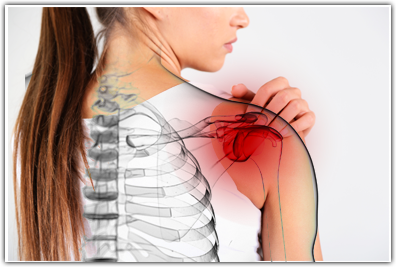SHOULDER THE PAIN: Frozen Shoulder Pain and You
You might think of the skeleton as a single structure. But actually your skeleton is divided into different systems, the primary and the appendicular. The shoulders, like the arms and hands, legs and feet, are part of the appendicular skeleton, which consists of appendages to the main body. The pelvis, sacrum, spine, rib cage, and skull all make up the axial (or primary) skeleton. This can be misleading, because the shoulder girdle plays an essential role in tying the two together.
The shoulder girdle is comprised of three pairs of bones: The shoulder blades (scapulae), collarbones (clavicles), and upper arm bones (humerus). These bones give the shoulder remarkable stability while also offering the widest range of motion of any joint in the body.
While muscle strength makes it possible to lift heavy objects, the movement of the shoulder blades is restricted by bulky muscles that limit the shoulder’s natural flexibility. Muscle tension around the shoulder restricts the natural range of motion and contributes to chronic shoulder tension.
The shoulder blades can be thought of as two hands on your back; the bottom of each scapula becomes the heel of the hand. Bend one arm with your hand by your shoulder and the elbow by your waist. Move the elbow slowly through the air. Notice when the elbow goes out behind you that your shoulder rolls forward. Moving your elbow forward reconnects the bottom of the shoulder blade with your rib cage and secures your shoulder in place. Do not lift your chest as you do this. Isolate the movement of the shoulders from the rib cage.
These simple exercises may relieve chronic tension in the shoulders and repair rotator cuff injuries that usually require surgery. The key is fastening the shoulders and training muscles to keep the shoulder girdle stabilized.
- Stand close to a wall and place your elbows on the wall at shoulder level, with your forearms and hands extending straight up from the elbows. Hold on to the wall with your hands as you begin to draw your elbows toward each other. You will feel some action around the shoulder blades as they secure into place. This is the position you will be in when you have completed the movement. Note that the shoulder blades have moved closer together. This simple movement often brings almost instant relief from a host of shoulder complaints.
- Hold a dowel or broomstick behind your head at the base of the skull. Note the position of the dowel or broomstick at the base of the skull, not behind the neck. Holding onto the stick, draw your elbows toward each other, as if trying to touch them together in front of you.
Here’s one final trick to help train the shoulders to stay in place:
- Roll your shoulders, one at a time, up, around, and back so that your shoulder blades fasten onto the back of the rib cage. Turn your palms up and place the back of your elbows at the front of your waist. Hold the elbows close to the body.
- Tight muscles will loosen and over-lengthened muscles will firm up. You can turn your palms down by keeping your elbows attached to your waist and rotating the lower arms below the elbows.
- Your shoulders carry a lot of the weight of your daily burdens; these simple stretches and posture improvements can keep your shoulders healthy and strong.

